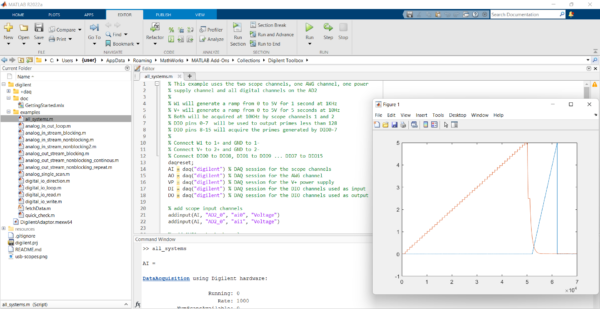So what is it?
The Digilent Test & Measurement Toolbox allows users to acquire and analyze data in MATLAB using Digilent’s test and measurment devices.
Featuring analog data streaming, digital I/O control, and configurable power supplies, users can easily collect and send data from Digilent Test and Measurement devices, either directly or with the newly added non-blocking functions with no software limitation on the sampling rate. Users familiar with the old Data Acquisition Toolbox Support Package for Digilent Devices will be pleased to hear that all of their old code can be seamlessly used with the new Toolbox.
So what is supported?
Hardware
A Digilent Test and Measurement device:
- Analog Discovery (Legacy)
- Analog Discovery 2
- Analog Discovery Studio
- Analog Discovery Pro (ADP3450/ADP3250)
- Discovery USB Programmable Power Supply (DPS3340)
- Electronics Explorer
Software
MATLAB (compatible with R2021b and newer)
The new Digilent Toolbox also relies on the MATLAB Data Acquisition Toolbox and WaveForms SDK. Note that by installing WaveForms to interact with your test and measurement device, you likely already have a WaveForms SDK installation.
So how do I use it?
A variety of example scripts are included that you can run within MATLAB using this plugin. One of these can be seen here. It uses two oscilloscope channels, one arbitrary waveform generator (AWG), one programmable power supply channel, and all the digital channels on the AD2 device, and can be easily modified to adjust how the instruments are used.

The guide “Getting Started with the Digilent Toolbox Add-on for MATLAB” on Digilent’s Reference site presents how to install and use the Digilent Toolbox add-on for MATLAB. Users working with the latest versions of MATLAB and Digilent’s WaveForms now have access to more devices and capabilities.
Final Notes
The Digilent Toolbox is also available on the Digilent – MATLAB repository on GitHub.
For more information about how to use WaveForms SDK, please visit the WaveForms SDK Reference Manual.
For technical support, please visit the Digilent Forums

